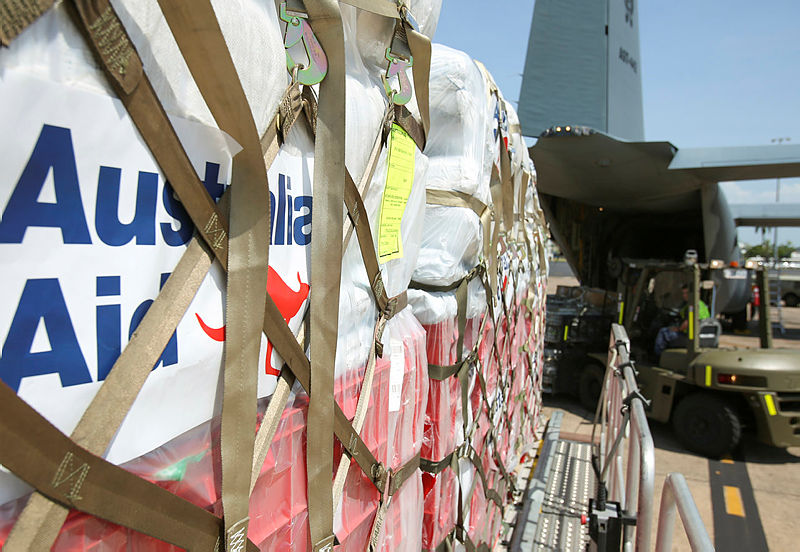Why Australia’s aid is a key soft-power asset
Posted By Dane Moores on November 6, 2018 @ 11:15

Australia’s overseas aid program is a highly effective, if underutilised and underappreciated, soft-power asset.
That claim might sound strange coming from someone who works for an international development NGO, known more for challenging conceptions of power than for reinforcing them. But, while the primary goals of Australia’s foreign aid are to contribute to sustainable economic growth and reduce poverty [1], the program also has strong benefits for Australia’s soft power and its international influence.
The 2017 foreign policy white paper [2] defines soft power as ‘the ability to influence the behaviour or thinking of others through the power of attraction and ideas’.
Through its soft power review [3], the Department of Foreign Affairs and Trade is examining Australia’s soft-power assets to ensure we build and leverage them as much as possible to promote Australia’s security and prosperity, and to strengthen Australia’s reputation in an increasingly networked world. The aid program should be front and centre of the review, as it is one of the primary conduits for Australia’s international influence.
The aid program contributes to Australia’s soft power in four key ways.
Aid strengthens our reputation and influence
Overseas aid portrays a vision of Australia as a helpful and generous nation—a good global citizen—that is an attractive development and strategic partner. The 2018 OECD peer review [4] of Australia’s aid program found that it positioned us well ‘to influence and enhance global co-operation’.
A 2014 study [5] on the relationship between US development projects and public opinion in sub-Saharan Africa concluded that aid can affect how donor countries are perceived, which has important consequences for economic and strategic influence.
Interestingly, seven of the nine countries ranked as having more soft power than Australia in the 2018 Soft Power 30 [6] index have larger aid programs as a proportion of gross national income. In fact, the aid budgets of each of the top three countries in the rankings—the United Kingdom, France and Germany—are at least double the size of Australia’s, when measured against national income.
Aid promotes Australian values
Aid is one of the strongest expressions of Australian values to the international community. Through Australia’s wide-ranging development footprint from the Pacific to Africa, Australian aid reflects our values of a fair go for all and racial equality. Through its women’s empowerment initiatives, the aid program exemplifies Australia’s values for gender equality and human rights.
By partnering with recipient countries in a transparent and collaborative way, Australia shows that, as a country and people, we value mutual respect. By investing in good and inclusive governance, foreign aid demonstrates the importance that Australia places on political, economic and religious freedoms.
Aid contributes to peace, stability and security
As aid investments promote development and reduce poverty, the likelihood of conflict falls. This dynamic is borne out in conflict research. According to one study [7], a country with a per capita income of US$250 per year has a relatively high likelihood (15%) of internal conflict over five years; the likelihood reduces to 1% in a country with a per capita income of US$5,000 per year. Clearly, poverty is a major source of insecurity and Australia’s efforts to reduce poverty have the flow-on effect of promoting peace, stability and security, which is in Australia’s interests.
If Australia didn’t support developing countries to grow and meet the needs of their populations, then weaker governance, lower rates of education, greater food and water insecurity, higher unemployment and poorer infrastructure would arguably add to instability in our region.
Aid builds mutually beneficial bilateral partnerships
Aid fosters positive development and diplomatic partnerships between donor and recipient countries. There’s also a positive correlation between aid flows and trade flows. Research suggests that aid increases exports to recipient countries more than other non-tying channels. For example, a study [8] by the Australian National University’s Development Policy Centre found that Australia’s aid program had positive and significant impacts on Australian exports to Asian countries between 1980 and 2013. According to the centre’s modelling, every $1 of Australian development assistance to Asian countries resulted on average in $7.10 in Australian exports to Asian countries, showing that there are commercial co‑benefits from foreign aid.
Australia’s aid program has deep and wide-ranging benefits for Australia’s soft power. However, as demonstrated by cuts to the aid budget over the past five years, the Australian government has neglected both the importance of international development and its soft power potential. Today, Australian aid expenditure is much lower than it was just a few years ago at a time when other countries, including China, are taking a more active role in development in the Indo-Pacific region.
Australia should step up its response to development challenges because, if it doesn’t, other countries will—potentially in ways that diverge from Australia’s interests and values. Australia should elevate its aid to be a core strategic asset of Australian foreign policy, alongside diplomacy and trade. The quantity and quality of our aid program should also be increased, given an aid program with stronger development outcomes is a better reflection on Australia.
An expanded aid program targeted towards the real purpose of aid—human development, especially through reducing poverty—would multiply the positive outcomes of Australian aid and improve Australia’s standing and influence in the world.
Article printed from The Strategist: https://www.aspistrategist.org.au
URL to article: https://www.aspistrategist.org.au/why-australias-aid-is-a-key-soft-power-asset/
URLs in this post:
[1] contribute to sustainable economic growth and reduce poverty: https://dfat.gov.au/aid/Pages/australias-aid-program.aspx
[2] foreign policy white paper: https://www.fpwhitepaper.gov.au/
[3] soft power review: https://dfat.gov.au/people-to-people/soft-power-review/Pages/soft-power-review.aspx
[4] 2018 OECD peer review: https://read.oecd-ilibrary.org/development/oecd-development-co-operation-peer-reviews-australia-2018_9789264293366-en
[5] 2014 study: http://www.horiuchi.org/www/Publications_files/100.00013036.pdf
[6] Soft Power 30: https://softpower30.com/
[7] study: https://www.brookings.edu/articles/the-threat-of-global-poverty/
[8] a study: http://www.devpolicy.org/australian-foreign-aid-impact-australian-exports-20170929/
Click here to print.